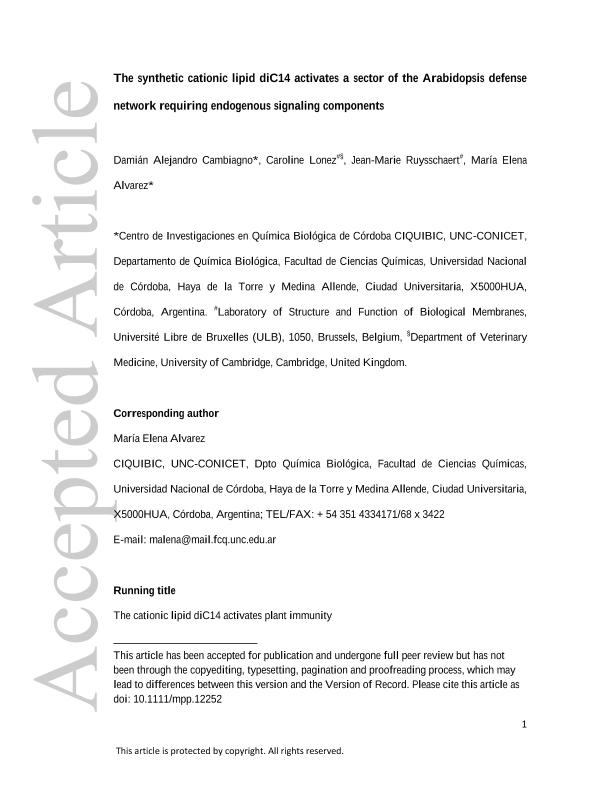Mostrar el registro sencillo del ítem
dc.contributor.author
Cambiagno, Damián Alejandro

dc.contributor.author
Lonez, Caroline
dc.contributor.author
Ruysschaert, Jean Marie
dc.contributor.author
Alvarez, Maria Elena

dc.date.available
2018-06-29T18:21:59Z
dc.date.issued
2015-12
dc.identifier.citation
Cambiagno, Damián Alejandro; Lonez, Caroline; Ruysschaert, Jean Marie; Alvarez, Maria Elena; The synthetic cationic lipid diC14 activates a sector of the Arabidopsis defence network requiring endogenous signalling components; Wiley Blackwell Publishing, Inc; Molecular Plant Pathology; 16; 9; 12-2015; 963-972
dc.identifier.issn
1464-6722
dc.identifier.uri
http://hdl.handle.net/11336/50741
dc.description.abstract
Natural and synthetic elicitors have contributed significantly to the study of plant immunity. Pathogen-derived proteins and carbohydrates that bind to immune receptors, allow the fine dissection of certain defence pathways. Lipids of a different nature that act as defence elicitors, have also been studied, but their specific effects have been less well characterized, and their receptors have not been identified. In animal cells, nanoliposomes of the synthetic cationic lipid 3-tetradecylamino-tert-butyl-N-tetradecylpropionamidine (diC14) activate the TLR4-dependent immune cascade. Here, we have investigated whether this lipid induces Arabidopsis defence responses. At the local level, diC14 activated early and late defence gene markers (FRK1, WRKY29, ICS1 and PR1), acting in a dose-dependent manner. This lipid induced the salicylic acid (SA)-dependent, but not jasmonic acid (JA)-dependent, pathway and protected plants against Pseudomonas syringae pv. tomato (Pst), but not Botrytis cinerea. diC14 was not toxic to plant or pathogen, and potentiated pathogen-induced callose deposition. At the systemic level, diC14 induced PR1 expression and conferred resistance against Pst. diC14-induced defence responses required the signalling protein EDS1, but not NDR1. Curiously, the lipid-induced defence gene expression was lower in the fls2/efr/cerk1 triple mutant, but still unchanged in the single mutants. The amidine headgroup and chain length were important for its activity. Given the robustness of the responses triggered by diC14, its specific action on a defence pathway and the requirement for well-known defence components, this synthetic lipid is emerging as a useful tool to investigate the initial events involved in plant innate immunity.
dc.format
application/pdf
dc.language.iso
eng
dc.publisher
Wiley Blackwell Publishing, Inc

dc.rights
info:eu-repo/semantics/openAccess
dc.rights.uri
https://creativecommons.org/licenses/by-nc-sa/2.5/ar/
dc.subject
Arabidopsis
dc.subject
Lipid Elicitors
dc.subject
Local And Systemic Defences
dc.subject
Pamp/Damp
dc.subject
Sa- And Ja-Dependent Pathways
dc.subject.classification
Otras Ciencias Biológicas

dc.subject.classification
Ciencias Biológicas

dc.subject.classification
CIENCIAS NATURALES Y EXACTAS

dc.title
The synthetic cationic lipid diC14 activates a sector of the Arabidopsis defence network requiring endogenous signalling components
dc.type
info:eu-repo/semantics/article
dc.type
info:ar-repo/semantics/artículo
dc.type
info:eu-repo/semantics/publishedVersion
dc.date.updated
2018-06-29T16:44:04Z
dc.identifier.eissn
1364-3703
dc.journal.volume
16
dc.journal.number
9
dc.journal.pagination
963-972
dc.journal.pais
Reino Unido

dc.journal.ciudad
Londres
dc.description.fil
Fil: Cambiagno, Damián Alejandro. Consejo Nacional de Investigaciones Científicas y Técnicas. Centro Científico Tecnológico Conicet - Córdoba. Centro de Investigaciones en Química Biológica de Córdoba. Universidad Nacional de Córdoba. Facultad de Ciencias Químicas. Centro de Investigaciones en Química Biológica de Córdoba; Argentina
dc.description.fil
Fil: Lonez, Caroline. Université Libre de Bruxelles; Bélgica
dc.description.fil
Fil: Ruysschaert, Jean Marie. Université Libre de Bruxelles; Bélgica
dc.description.fil
Fil: Alvarez, Maria Elena. Consejo Nacional de Investigaciones Científicas y Técnicas. Centro Científico Tecnológico Conicet - Córdoba. Centro de Investigaciones en Química Biológica de Córdoba. Universidad Nacional de Córdoba. Facultad de Ciencias Químicas. Centro de Investigaciones en Química Biológica de Córdoba; Argentina
dc.journal.title
Molecular Plant Pathology

dc.relation.alternativeid
info:eu-repo/semantics/altIdentifier/url/http://onlinelibrary.wiley.com/doi/10.1111/mpp.12252/abstract
dc.relation.alternativeid
info:eu-repo/semantics/altIdentifier/doi/http://dx.doi.org/10.1111/mpp.12252
Archivos asociados
